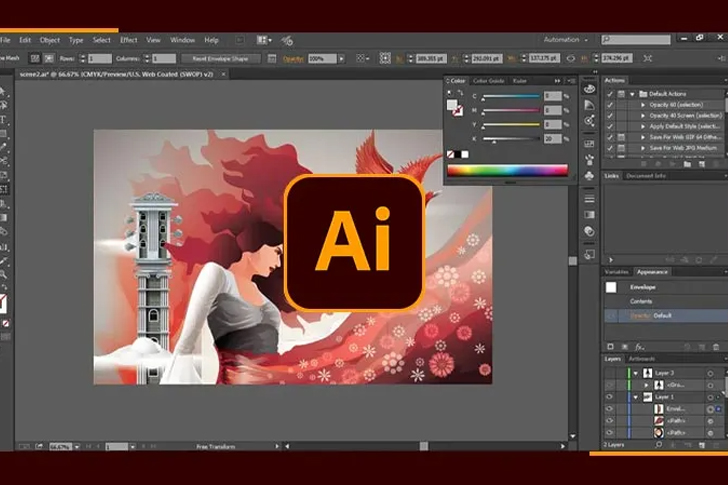Key Techniques in Adobe Illustrator for Effective Graphic Design
Adobe Illustrator, a powerful tool for graphic designers, has been a market leader in vector graphic design software. It enables users to create sophisticated artwork for virtually any medium. Graphic design and illustration are no longer confined to traditional boundaries, but are boundless with the aid of robust tools such as Illustrator. This article explores key techniques that can elevate your skills and ensure your designs stand out.

Understanding Vector Basics: The Foundation of Illustrator
Vector graphics, which are composed of paths rather than pixels, are a central aspect of Adobe Illustrator. These paths are made up of a series of points connected by curves or lines, allowing the graphics to be scaled infinitely without loss of quality. This is particularly beneficial for creating logos, icons, and other designs that need to be resized frequently. As per a survey conducted by Graphic Design USA, over 90% of professional designers use Adobe Illustrator primarily for creating vector graphics, underscoring its importance in modern design workflows.
Mastering the Pen Tool: Precision at Your Fingertips
The Pen Tool is perhaps one of the most powerful tools within Adobe Illustrator. It allows for the creation of precise paths and is essential for drawing complex shapes and making adjustments down to the single pixel. Mastery of the Pen Tool involves understanding Bezier curves, which can be tricky for beginners but are incredibly effective once learned. Illustrators who can skillfully use the Pen Tool can enhance their artwork’s accuracy and detail significantly, thereby enriching the overall design.
Utilizing Layers and Groups to Organize Your Artwork
Effective organization is key in handling complex designs. Illustrator allows for intricate layering and grouping, which can simplify working with multiple elements. By organizing artwork into layers and groups, designers can easily lock, hide, or isolate portions of their design, making the workflow more manageable. According to a recent workflow analysis, graphic designers save approximately 20% of their time by effectively using layers to manage their designs in Illustrator.
Exploring the Power of Color with Global Colors and Color Harmonies
Color management is a fundamental aspect of graphic design, and Illustrator’s Global Colors is a feature that provides tremendous advantages. When a Global Color is modified, all instances of that color in your document are updated simultaneously, ensuring consistency and saving time. Additionally, Illustrator’s color harmony tools help designers in choosing palettes that are aesthetically pleasing and compliant with brand guidelines.
Creative Text Manipulation and Typography
Illustrator is not only for graphical elements but also offers extensive capabilities for text manipulation, making it a versatile tool for typographical design. With features like character styles, paragraph styles, and text along a path, designers can create dynamic textual content that complements their designs. Statistics reveal that leveraging Illustrator’s advanced typography tools increases the readability and engagement of media content by up to 30%.
Enhancing Designs with Effects and Appearances
The Effects menu in Illustrator is a gateway to creating unique graphics with depth and dimension. From drop shadows and glows to complex distortions and textures, these effects can transform basic illustrations into detailed works of art. Moreover, the Appearance panel allows designers to manage all aspects of an object’s appearance without altering the underlying structure, offering flexibility in editing and experimentation.
Integrating with Other Adobe Creative Cloud Applications
For many professionals, the ability to integrate across various applications within Adobe Creative Cloud enhances productivity. Illustrator works seamlessly with Photoshop, InDesign, and other tools, providing a comprehensive workflow for all types of design projects. This integration facilitates the exchange of assets and maintains consistency across various media, a crucial factor in tight-deadline and multi-platform campaigns.
Staying Updated with New Features and Community Resources
Adobe frequently updates Illustrator with new features, improved functionalities, and bug fixes, maintaining its position at the forefront of graphic design technology. Participating in forums, watching tutorials, and using online resources provided by Adobe and its community can help designers keep pace with these updates and continuously refine their skills.
Conclusion: Elevating Your Design Toolkit
Adobe Illustrator remains an essential tool for graphic designers worldwide, known for its robustness, precision, and versatility in vector graphic creation. By mastering key techniques such as the Pen Tool, layers, color management, and text manipulation, designers can significantly enhance their creativity and productivity. Whether you are creating digital illustrations, marketing materials, or brand identities, understanding and applying these techniques in Adobe Illustrator can lead to more effective and stunning graphic designs.







Recent Comments